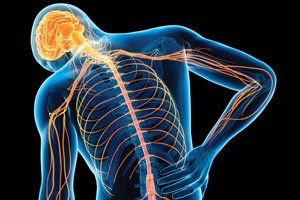Scientists have many different theories about pain and the best ways to get control of your pain. One popular idea is called the pain gate control theory.
The pain gate control theory states that “gates” allow certain sensations to pass along paths to your brain. The ones that don’t make you feel pain, pass through the “pain gate” and then help close the gate so the pain cannot reach your brain.
Therefore, you may be able to decrease or eliminate pain that you are feeling by allowing only “safe” and sensations that aren’t painful pass through the gate to your brain.
ANATOMY OF PAIN: Let’s keep the anatomy of pain simple. Nerve endings travel from all parts of your body to your spinal cord and, ultimately, into your brain. These nerves serve as pathways where stimuli travel. Stub your toe, and an impulse is generated that quickly moves from your toe to your brain. Your brain then interprets what has happened to your poor toe.
Based on your current location (in the shower) and your previous experiences there (you’ve stubbed your toe on that silly door jamb before), your brain knows what happened and the noxious stimulus that occurred as a result of banging your toe is felt as pain.
PURPOSE OF PAIN: When something that may harm your body like a hot stove or a sharp knife, meets specialized nerves, pain may be felt. This alarm tells your brain that something dangerous may be happening to your body and that prompt attention should be given to the painful stimulus to protect your body against the problem.
Pain can be tricky, because pain may be sensed by your brain when there is no actual emergency or potential harm to your body. The sensation of pain is complex, and other factors besides nerves sending signals to your brain may be at play. Other variables that may affect the way you feel pain may include:
- What your experience with pain has been
- Your expectations and beliefs about pain
- Anxiety
- Depression
- Your current environment and surroundings
These factors, along with actual pain stimuli from your body to your brain, shape how you feel pain and how your body reacts to it. Thus, the feeling of pain in your body is multi-factorial: it occurs as a result of all your past experiences and future expectations mashing into each other in your complex brain.
Some people with significant injuries fail to feel pain. Imagine a soldier on a battlefield. They are under intense enemy fire, and a bullet grazes their arm. They may report very little pain felt at that time since the main goal at that point in time is merely getting to safety. Therefore, the soldier’s brain may not pay much attention to the wound caused by the bullet until they are out of harm’s way on the battlefield.
Other people with very little or no tissue damage experience intense pain. Perhaps someone develops low back pain that is constant in nature and limits the person’s ability to move properly. Diagnostic studies like X-rays or MRIs may show no tissue damage or injury, yet the person still experiences intense and debilitating pain.
Thus, our body’s alarm system is imperfect. The presence or absence of pain does not always give an accurate representation of the status of the body’s tissues.
NEXT WEEK: How to address your pain.
Submitted by Katesel Strimbeck PT, MS, MHA. Katesel has been a PT for 22 years, is Director of Rehabilitation Services at North Country Hospital, and a member of the American Physical Therapy Association.
Reference: Sears, B., (December 2019). The Pain Gait Control Therapy. Verywell health. Retrieved from: https://www.verywellhealth.com/the-pain-gate-control-theory-4587360


